Many homeowners and lawn experts favor a St. Augustine turf due to its extraordinary ability to withstand shade, high temperatures, and drought. However, there are still quite a few problems that you might come across in St. Augustine grass lawns despite implementing a proper lawn care plan. In this article, you will learn about St Augustine grass diseases problems.
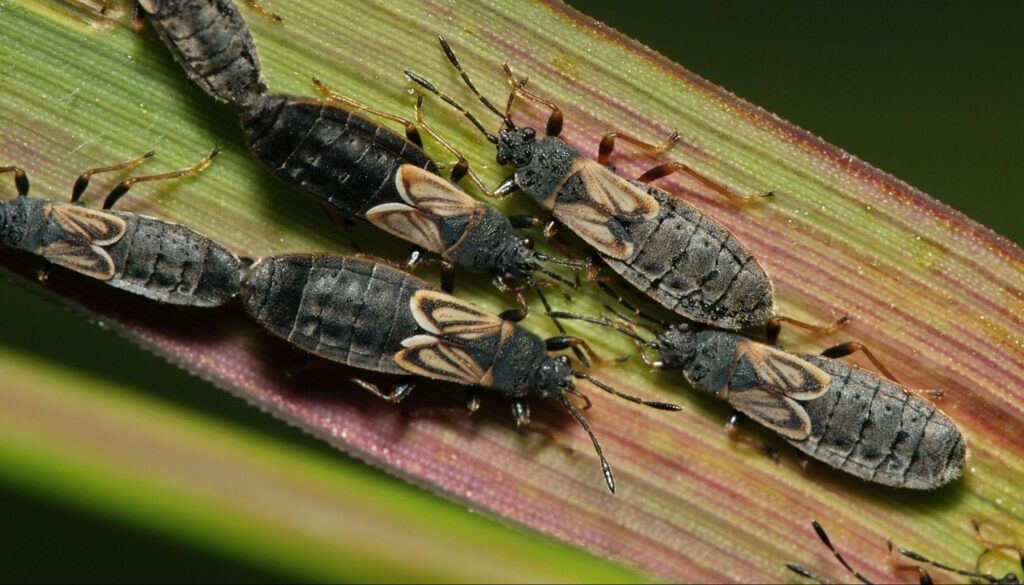
Chinch Bugs: Tiny bugs that feed on grass blades in St. Augustine lawns.
More often than not, St. Augustine grass fungus is the main culprit behind these lawn issues, causing disease problems such as take-all root rot, gray leaf spot, and brown patch disease.
However, other than fungal diseases, St. Augustine home lawns and other St. Augustine turf areas also have to deal with lawn pests such as chinch bugs and sod webworms.
If not taken care of in time, St. Augustine grass pests and diseases can result in significant damage. Poor lawn maintenance can quickly turn a perfectly healthy St. Augustine lawn into a patch of dead grass.
So, let’s go ahead and discuss some of the most common St. Augustine lawn problems and what you can do to keep your St. Augustine lawn healthy and flourishing. Happy Reading!
How Do You Diagnose St. Augustine Grass Problems?

Fungal threads: A sign that your lawn has been infested with fungus.
Before we introduce you to the common diseases and problems of St. Augustine grass, you should know that it is a warm-season grass and like other warm-season grasses, it enters dormancy in the early winter months when temperatures fall below 55 degrees Fahrenheit or 12 degrees Celsius.
When dormant, the grass blades turn yellow or dark brown. However, this does not mean that your St. Augustine grass is dead or attacked by a fungal disease.
So, make sure you do not confuse dormant St. Augustine grass with sick or infected St. Augustine grass. They both look quite similar in certain situations and can confuse a person easily. Nonetheless, if you notice any of the following signs and symptoms on your St. Augustine lawn, it is time to consult a lawn professional.
Signs and Symptoms
If your healthy lawn is showing signs of stress even after implementing a proper lawn care plan, there is a big chance that your St. Augustine grass is dealing with pests, fungus or weeds. So, keep an eye out for the following signs so you can identify and treat the problem before it is too late:
Irregular Brown Spots
Most fungal diseases manifest themselves in the form of brown patches on your otherwise green St. Augustine lawn. The size of a brown patch can vary from a few inches to several feet in diameter.
A brown patch is usually characterized by pale yellow grass, but the leaf blades might turn dark brown in severe fungal disease.
Dark Brown Color Stolons
Stolons are creeping horizontal grass stems that have nodes along their entire length which can give rise to new grass plants. So if you notice that your St. Augustine grass stolons have turned brown, there is a big chance that it is due to a fungal disease.
Yellowing Grass
Even if, despite maintaining a proper lawn care schedule, the grass blades of your St. Augustine grass are turning yellow, it can be due to fungal diseases, pest infestations or weed invasions. The symptoms are usually severe in shaded areas where the grass does not have access to full sun.
Weak Grass Roots
In the case of a disease, the root system usually becomes weak and loses its strength. So, if you are able to pull out grass roots easily from the soil surface, there is a big chance that the grass has been attacked by a fungus or lawn pest.
Fungal Threads
If you see a leaf blade with threads of fungus attached to it, you should better call the local county extension office, get the number or address of a soil testing lab, and get your soil tested for St. Augustine grass fungus.
RELATED: St. Augustine Grass 101: Is It Any Good? And, How To Grow It In Your Yard?
Common St. Augustine Grass Diseases
Now that you know some of the most common signs and symptoms of a diseased St. Augustine lawn, let’s go ahead and look at some of the most prevalent St. Augustine grass diseases in more detail and what you can control or treat them.
Gray Leaf Spot Disease
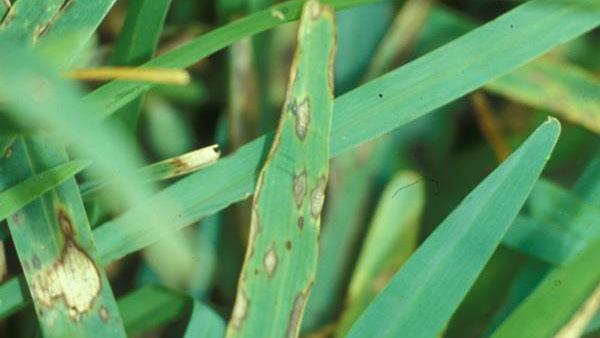
Gray leaf spot disease.
It is a common fungal disease of turf grasses, including St. Augustine. In gray leaf spot disease, the leaf spots are initially small, brown, and round.
However, the leaf spots start becoming oval and elongate as time passes. The color of the leaf spot also changes from brown to dark brown. Once mature, the final leaf spots are covered by purple or dark borders on the sides.
In addition to that, a general yellow halo may also be present around the gray spots. During hot and humid weather, the fungus produces numerous spores and a cottony fungal growth on the foliage, giving the grass a gray appearance; hence it is called the gray leaf spot disease. If the number of spots is too high, grass will wither and die.
Management
To avoid gray leaf spot disease from taking hold of your lawn, make sure that humid conditions do not persist on your lawn. Remove thatch regularly and do not use high nitrogen fertilizers.
Also, it is better not to use the grass clippings from affected areas as compost on your lawn. Fungicides can also be used if needed.
Take-all Root Rot (TARR)
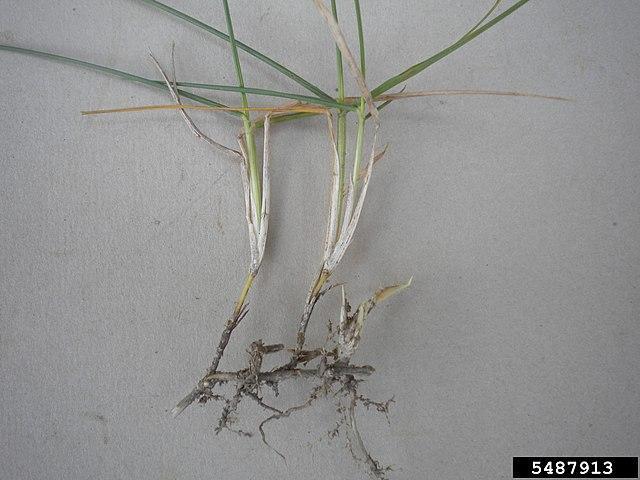
Take-all root rot.
Take-all root rot is caused by the fungus Gaeumannomyces graminis var. The fungus lives in the soil and is naturally present in the roots of most warm-season grass types.
Typically, the disease attacks St. Augustine lawns in early fall, especially when there is abundant rainfall. The presence of dead grass or other decaying organic matter like thatch for prolonged periods of time on your lawn can increase the chance of TARR infection.
Early symptoms of the disease include yellowing foliage that eventually turns brown. Following that, the turf starts to thin and irregular patches of brown start forming on the lawn. The margins of these patches are bronze to yellow-orange. In some cases, the patches keep appearing in the same areas of the lawn year after year.
Management
Fungicide treatments can be used if needed. However, we suggest using Sphagnum Peat Moss over the affected area.
You can apply around a one-inch thick layer of Sphagnum Peat Moss as a topdressing on your lawn. The acidic nature of the moss will prevent the fungus from speeding as it becomes inactive in an acidic environment.
RELATED: How To Revive St. Augustine Grass | Why Is My St. Augustine Dying
Brown Patch Disease
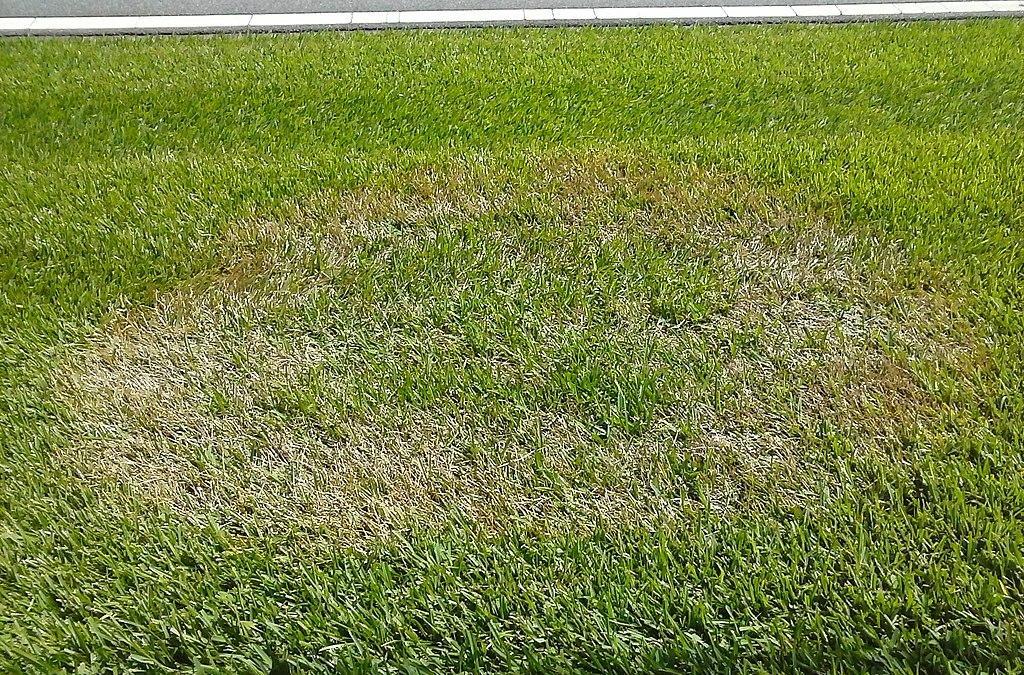
Brown patch disease.
The disease is caused by Rhizoctonia solani, also known as brown patch fungi. Mild temperature, humid days, and cool nighttime temperatures are all perfect conditions for its growth.
The appearance of brown patch disease varies greatly with soil type and conditions. However, thin patches of yellowed grass in almost circular shapes are a common sign of brown patch disease.
As the disease progresses, the patches start to run reddish-brown and then become straw-colored. To differentiate brown patch disease from other ailments of St. Augustine, look at the junction between the leaves of the grass and the stem.
Brown patch fungus causes this area to turn black. Thatch build-up in the lawn also creates favorable conditions for the brown patch fungi.
Management
Use slow-release nitrogen fertilizers and keep records of areas that are actively affected by the disease. The high activity areas then can be targeted with appropriate fungicides. However, fungicides work best when they are used as a preventative measure.
Fairy Ring Disease
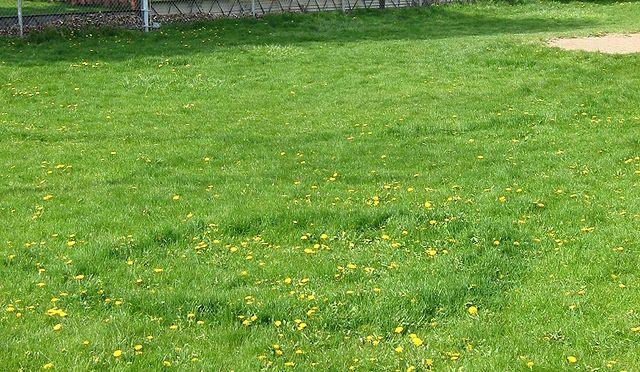
Type 2 fairy ring disease.
Fairy ring disease is caused by a number of mushroom-forming fungi that are known as Basidiomycetes. According to folklore, fairy rings form on the lawn after fairies dance on it.
The disease manifests itself in the form of mushroom circles or arches over the lawn or grass surface. The disease is most likely to affect a lawn in spring or fall. Rainy season, moist soil, and increased organic matter are all perfect conditions for the growth of fairy ring fungi.
The grass near the rings becomes dark green colored as the mushrooms actively release nitrogen in the soil, promoting grass growth.
Researchers divide fairy rings into three types: Type 1 rings are characterized by wilted, brown, dead grass circles. Type 2 rings show circles of dark green grass, and in type 3 rings, mushrooms appear on the lawn.
Management
You can treat fairy ring disease by applying appropriate fungicides to the soil. However, the use of fungicides is not recommended in home settings. So, it is better to use cultural control methods such as preventing thatch build-up, reducing moisture etc., to control fairy ring fungi on your lawn.
Nigrospora Stolon Rot
It is a relatively new disease of St. Augustine grass. The condition girdles the stolons of St. Augustine, which results in water and nutrient deprivation.
As a result, the stem and leaves appear under severe drought stress. If not treated on time, they soon become totally desiccated. Unlike other diseases mentioned above, drought and high temperature favor the Nigrospora Stolon Rot, which is quite unusual.
Initial symptoms include the appearance of dark brown or reddish lesions on the stolons. Once the disease progresses, the lesions start to enlarge and then they encircle the entire stolon, restricting the movement of water and nutrients. The symptoms of Nigrospora Stolon Rot are similar to those caused by chinch bugs.
Management
Providing adequate moisture via supplemental irrigation, raising the mowing height and the use of Daconil (8 ounces per 1000 square feet) at two to three-week intervals offers a reasonable control of the Nigrospora Stolon Rot.
Other St. Augustine Lawn Problems
Fungi is not the only issue you need to be aware of when building a St. Augustine lawn. In this section of the article, we will look at the other common problems you might encounter on your Augustine lawn.
Chinch Bugs

Chinch bugs inject St. Augustine grass with a toxin that prevents water movement in leaf blades.
While St. Augustine usually does not attract a lot of pests, it is still highly vulnerable to chinch bug infestation. These hard-to-spot chinch bugs not only feed on the grass blades, but they even actually remove fluids from them and inject toxins.
Chinch bug damage usually appears on the grass blades in the form of small yellow spots. You will know that you have a chinch bug problem if watering a dead spot does not brighten it. Chinch bugs are usually present in the sunniest part of the lawn and if you are trying to scope them out, slowly water the grass.
Keep watering and you will see bugs float on the surface in case of a chinch bug infestation. However, it is not an infestation if you only see two or three bugs on your grass. However, if there are more than twenty chinch bugs in a square foot of the grass, you have a problem.
Chinch Bug Control
In many cases, chemical control of chinch bugs is not needed. According to the Center for Agriculture, Food, and the Environment of Massachusetts University, lawns that receive adequate water and fertilization can tolerate chinch bugs without sustaining damage. Also, many yards have natural chinch bug predators that can keep their numbers in check.
Weeds

Chickweed: A common St. Augustine lawn weed.
Even though St. Augustine is a pretty hardy grass, it can still fall victim to lawn weeds if a proper care plan is not implemented.
Broadleaf weeds are usually the most common weeds attacking or invading a St. Augustine lawn. Some examples are dollar weed, crabgrass, goosegrass, henbit, clover, and chickweed.
A preemergence can be applied early in the year to prevent the weeds from growing onto your lawn. However, even if some weeds still appear on the lawn, it is time to turn toward post-emergence herbicides.
Some weeds will require more than one treatment. Also, make sure that you do not use a non-specific herbicide.
A non-specific herbicide can also kill or damage desirable plants and the grass growing on the lawn. Last but not least, maintain healthy turf. A healthy turf on its own is the best defense against lawn weeds.
RELATED: How To CORRECTLY Plant St. Augustine Grass Using Plugs? The Ultimate Guide
Frequently Asked Questions (FAQs)
How do I know if my St. Augustine grass has fungus?
Stolons turning brown, patches of brown color appearing on the lawn surface, random yellowing of grass blades, and the presence of fungal threads on grass are some of the common signs of fungal diseases.
If you see any of these symptoms on your lawn, there is a high chance that a fungus has infested your lawn and your lawn needs help.
How to get rid of fungus on St. Augustine grass?
As already stated, fungus grows best in moist, shady and soils rich in organic matter. So, start by reducing the humidity of your lawn, do not use high nitrogen fertilizers, do not let thatch sit around on the grass and finally, use fungicides to get rid of the fungus.
How do I get rid of grub worms in St. Augustine?
We suggest using a mixture of dish soap in water. Spray the mixture on the lawn or affected areas of your lawn, and the soap solution will suffocate and smother the grub worms. The combination can also be used to kill beetles on your lawn and prevent them from laying eggs on the grass.
Sources for Further Reading
Diagnosing Problems of St. Augustinegrass – Center for Urban Agriculture. Retrieved 28 April 2022, from https://ugaurbanag.com/diagnosing-problems-of-st-augustinegrass/
Gray Leaf Spot on St. Augustinegrass. (2022). Clemson University Cooperative Extension Service. Retrieved 28 April 2022, from https://hgic.clemson.edu/factsheet/gray-leaf-spot-on-st-augustinegrass/
Lawn Diseases: Prevention and Management Guidelines–Agriculture and Natural Resources, University of California. (2022). Retrieved 28 April 2022, from http://ipm.ucanr.edu/PMG/PESTNOTES/pn7497.html
Editor’s Recommendations
Now that you know how to treat St. Augustine grass diseases problems, make sure to check out our other articles:
10+ Natural Pest Control for Houseplants to Protect Them from Insects and Diseases
How To Use a 2,4-D Lawn Weed Killer To Control Weeds? (And Is It Safe?)
Common Weeds That Look Like Grass (and How To Get Rid Of Grassy Weeds)







